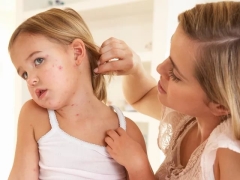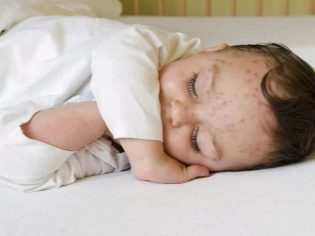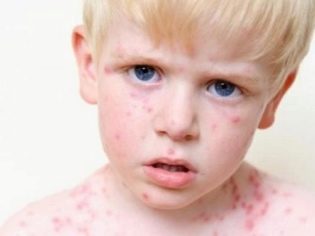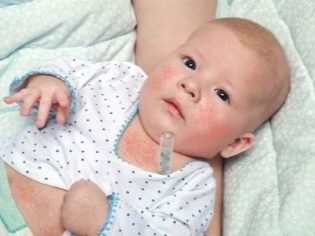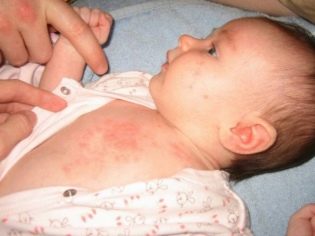Infectious exanthema in children
Every day, district pediatricians in their practice meet with various skin rashes in babies. One of the pathologies that is accompanied by the appearance of a skin rash is rash.
What it is?
The acute reaction of a child’s body to various infections with the appearance of a rubella-like skin rash is called exanthema. The prevalence of this childhood disease throughout the world is quite high. Infectious rash can occur in both boys and girls. Doctors register a lot of cases of the disease in newborns and infants.
Most often in children's practice, sudden rash occurs. The peak of its incidence is at the age of 2-10 months.
The first adverse symptoms occur even in the youngest patients. A specific skin rash appears, as a rule, after a very high temperature.
Such an acute reaction of a child’s body is caused by a bright immune response to the penetration of an infectious pathogen into it.
Older children and adolescents suffer from this disease much less often. In adults, infectious exanthema is practically not found. Such a high incidence in children is associated with a special functioning of their immune system. The immunity of some babies reacts to various infections rather rapidly and vividly, which is accompanied by the appearance of specific symptoms of the disease on the skin.
Many years ago, doctors used the term "Six day illness". So they called sudden rash. The essence of this definition is that the clinical symptoms of the disease completely disappear in a sick child on the sixth day. This name is currently not used. In some countries, doctors use different terminology. They call a sudden rash of a baby roseola, pseudo-redberry, 3-day fever, roseola infantum.
There is also another, quite common form of the disease called boston rash This is an acute pathological condition that occurs in babies as a result of ECHO infection. During the course of the disease, a child has a macula-like rash, high fever, and also severe symptoms of intoxication syndrome. Scientists have already identified the causative agents of the disease. These include some subspecies of ECHO viruses (4,9,5,12,18,16) and less commonly Coxsackie viruses (A-16, A-9, B-3).
In the case of the Boston exanthema, the pathogens enter the body of the child by airborne droplets or nutritional (with food). Cases of Boston exanthema in newborn babies are described. In this case, the infection occurred intrauterinely.
Scientists say that lymphogenous dissemination of viruses is also actively involved in the development of the Boston exanthema.
The reasons
The causative agent of sudden exanthema was discovered by scientists at the end of the 20th century. It turned out to be herpes virus type 6. This microorganism was first found in the blood of surveyed people who suffered from lymphoproliferative diseases. The herpes virus has its main effect on specific cells of the immune system - T-lymphocytes. This contributes to the fact that there are significant violations in the work of immunity.
Currently, scientists have obtained new results of scientific experiments, which show that the virus herpes type 6 It has several subtypes: A and B. They differ from each other in molecular structure and virulent properties. It has been scientifically proven that sudden viral rash in children is caused by the herpes virus type B. The A subtype viruses can also have a similar effect, but there are currently no confirmed cases of the disease. After viruses enter the body, processes of a violent immune response are triggered, which in some cases proceeds rather rapidly.
The inflammatory process leads to a strong edema of collagen fibers, expansion of blood vessels, pronounced cell proliferation, and also contributes to the development of characteristic eruptions on the skin.
Scientists identify several causes that may cause the child signs of infectious rash. These include:
- Bacterial infections. Bacteria cause the appearance of clinical signs of disease in babies much less frequently than viruses. In this case, the most susceptible to the development of infectious exanthema are babies with signs of pronounced immunodeficiency or often ill children.
- Viral infections. They are the most common cause of the appearance of characteristic rashes on the skin. Enterovirus infection, influenza, children's quarantine diseases can provoke specific signs on the baby’s skin.
- Parasitic diseases. The toxic effect on the children's body of the waste products of helminths leads to the fact that the baby disrupts the proper functioning of its own immune system. It must be said that parasites cause the disease quite rarely.
- Tendency to severe allergic reactions. Having a child over-inclined toward various allergies often due to impaired function of the immune system.
- Various immune responses. These include: immunocomplex, cytotoxic and autoimmune. Such reactions occur when the child has individual hypersensitivity and defects in the immune system.
What happens in the body?
Most often, babies are infected from each other by airborne droplets. There is another variant of infection - contact-household. Doctors note some seasonality in the development of this disease in children. The peak in the incidence of infectious exanthema usually occurs in spring and autumn. This feature is largely due to a decrease in immunity during seasonal colds.
The microbes which have got to a children's organism promote activation of an immune response. It should be noted that after suffering an infection of herpes type 6, many children have strong immunity. According to statistics, Most often, babies in the first year of life and children under the age of three years are ill. American scientists conducted scientific studies in which they showed that the majority of apparently healthy people examined have antibodies to the herpes virus type 6 in their blood. Such a high prevalence indicates the importance of studying the process of the formation of infectious exanthema at different ages.
Sources of infection are not only sick kids. They can also be adults who are carriers of the herpes virus type 6.
Doctors believe that infection with this herpetic infection occurs only if the disease is in an acute stage, and the person releases viruses into the environment along with biological secrets. A large concentration of microbes is usually found in the blood and saliva.
When viruses enter the children's organism and their effect on T-lymphocytes, a whole cascade of inflammatory immune reactions is triggered. First, an Ig M child appears. These protective protein particles help the child’s body to recognize viruses and activate the immune response.It is important to note that in newborn babies who are breastfed, the level of Ig M is much higher than the similar indicators of children who receive artificial adapted mixtures as food.
After 2-3 weeks from the moment of the onset of the disease, the other protective antibodies, Ig G, appear in the baby. Increasing their concentration in the blood indicates that the child’s body “remembered” the infection and now “knows its face”. Ig G can remain for many years, and in some cases even for a lifetime.
The peak of increasing their concentration in the blood is usually the third week after the onset of the disease. Detecting these specific antibodies is easy. For this special serological laboratory tests are carried out. To carry out such an analysis, the baby is preliminarily collected venous blood. The accuracy of the result obtained from a laboratory test is usually at least 90-95%.
For a long time, scientists were concerned with the question: is it possible to reinfection (infection) with a virus again? In order to find the answer, they conducted a lot of research. Experts have found that the herpes virus type 6 is able to infect and persist for a long time in monocytes and macrophages of various tissues of the body.
There are even studies confirming that microbes are capable of manifesting on bone marrow cells. Any reduction in immunity can lead to reactivation of the inflammatory process.
Symptoms
The appearance on the skin rash in babies is preceded by an incubation period. For a sudden exanthema, it is usually 7-10 days. At this time, as a rule, the baby has no signs of the disease. After the end of the incubation period, the child's temperature rises greatly. Its values can reach 38-39 degrees. The severity of temperature increase may be different and depends mainly on the initial state of the child.
Very little kids usually suffer the disease quite hard. Their body temperature rises to febrile values. Against the background of pronounced febrile, the child, as a rule, has a fever and severe chills. Toddlers become easily excitable, tearful, poorly go on contact even with close relatives. Suffering and baby's appetite. During the acute period of the disease, children usually refuse to eat, but can beg for “sweets”.
The baby appears marked increase in peripheral lymph nodes. Most often the cervical lymph nodes are involved in the process, they become dense to the touch, soldered to the skin. Palpation of enlarged lymph nodes may cause a child soreness. The baby has severe nasal congestion and runny nose. It is usually slimy, watery. The eyelids are swollen, the expression on the baby’s face takes on a somewhat sullen and painful look.
When viewed from the throat, you can notice moderate hyperemia (redness) and friability of the back wall. In some cases, specific areas of maculopapular rash appear on the upper palate and uvula. These foci are also called Nagayama's spots. After some time, the conjunctiva of the eye becomes injected. The eyes look painful, in some cases they can even water.
Usually, 1-2 days after the appearance of high temperature, the child has a characteristic sign - roseola rash. As a rule, it has no special localization and can occur in almost all parts of the body. During a skin rash, the child's temperature continues to increase. In some cases, it rises to 39.5-41 degrees.
However, a distinctive feature of febrile in infectious exanthema is that the baby practically does not feel it.
During the whole period of high body temperature, the child’s well-being does not suffer much. Many babies retain their activity, despite the persistent febrile.Usually, the temperature normalizes to 4 or 6 days from the onset of the disease. Infectious sudden rash is a very mysterious disease. Even the lack of treatment leads to the fact that the child's condition normalizes independently.
Distribution of rash over the body usually occurs when the temperature drops. Skin rashes begin to spread from the back to the neck, arms and legs. Bulk elements can be different: maculopapular, roseolous or macular. A separate skin element is represented by a small red or pink speck, the size of which is usually does not exceed 3 mm. When pressing on such elements - they begin to turn pale. As a rule, loose elements in infectious exanthemas do not itch and do not bring any discomfort to the child. It should also be noted that skin rashes practically do not merge with each other and are located at some distance from each other.
Some babies have a rash on their face as well. Usually, loose elements remain on the skin for 1-3 days, after which they disappear on their own. Traces and residual effects on the skin, as a rule, does not remain. In some cases, there may be only a slight redness, which also passes on its own without the appointment of any special treatment.
It should be noted that the infectious rash of infants in children under three years of age is much easier than in older children. Doctors mark the most severe course of this pathological condition in adolescents.
Their body temperature rises greatly, and their well-being deteriorates significantly. Paradoxically, babies of infants tolerate high febrile conditions in infectious exanthema much easier than schoolchildren.
What does a rash of infants look like?
Babies younger than a year often have specific symptoms of this disease. The appearance of a skin rash leads parents into real confusion. The high body temperature in a child makes them think about a viral infection. This leads to the fact that frightened parents urgently call the doctor to the house. The doctor usually diagnoses a viral infection and prescribes an appropriate treatment that does not save the baby from the rash that appears on the skin.
Infectious rash is specific manifestation of an altered reaction of the immune system in response to the entry of a pathogen. If your child has an individual hypersensitivity, skin rashes will occur even with the use of special antiviral drugs. Many parents ask a reasonable question: is it worth treating? Helping the child's body in the fight against infection is certainly worth it.
Infectious rash in a newborn child has no pronounced clinical features. For 1-2 days from the moment of high temperature, the baby also has skin rashes. The skin of infants is quite tender and loose. This leads to the fact that the rash spreads over the body quickly enough. After a day, skin rash elements can be found on almost all parts of the body, including the face.
The state of health of the child during the period of high temperature suffers slightly. Some babies may refuse breastfeeding, however, most babies continue to actively eat. One of the manifestations of infection in infants is often the appearance of diarrhea. Usually this symptom is transient and disappears completely when the temperature normalizes.
The course of the disease in children up to three years is the most favorable. Recovery usually occurs on the 5-6 day from the moment the first adverse symptoms appear.
Many children have lifelong immunity after an illness. Only in a small number of cases there are repeated cases of reinfection.
The starting point in the appearance of an aggravation in such a situation, doctors consider a decrease in immunity.
Treatment
Infectious rash is one of the few childhood diseases that have the most favorable prognosis. It usually proceeds fairly easily and does not cause any remote effects or complications of the disease in the child. Doctors note a serious course of the disease only in children with pronounced manifestations of immunodeficiency states. In this case, in order to eliminate the adverse symptoms, such children are given a mandatory course of immunostimulating therapy. This specific treatment is prescribed by a pediatric immunologist.
For sick children with infectious exanthem, doctors offer a number of recommendations to help improve the child's well-being and speed up his recovery. They recommend that the entire acute period of the disease, especially since the rash appears on the skin, the child must have spent at home. When the body temperature is high, the baby is given bed rest. Active walks on the street at this time should be postponed until recovery.
During severe fever, do not wrap the baby too much. This only contributes to a strong overheating of the baby and disrupts the process of protective natural thermoregulation. Fever with infectious exanthema is therapeutic in nature. It helps the child's body fight viruses. Choose comfortable warm clothes for your child, which will protect your baby from hypothermia.
Opinions of doctors about hygiene procedures are divided. Some experts believe that it is possible to bathe a baby with an infectious rash, and even contribute to the fact that the child begins to feel much better. Other children’s doctors recommend putting off bathing and baths for several days until body temperature is normalized. The choice of tactics remains for the attending physician who observes the baby. However, the daily toilet of the child can be done without any restrictions.
Appointment of special antiviral drugs for the treatment of infectious exanthema in children is not required. This condition will pass on its own within a few days.
It is important to note only that, despite the favorable prognosis of the course of the disease, the condition of the baby should be carefully monitored. When the deterioration of health should be sure to contact your doctor.
Prevention
Unfortunately, scientists have not developed a specific prevention of infectious exanthema at the present time. As a non-specific preventive measures, doctors recommend to follow all the rules of personal hygiene and avoid any contact with fever and sick people. During mass outbreaks of infectious diseases in children's educational institutions, quarantine must be introduced. Such measures will significantly reduce the possibility of infection with viral infections and help prevent the appearance of signs of an infectious exanthema on the baby’s skin.
In the next video doctor Komarovsky examines all possible causes of rash in children.
